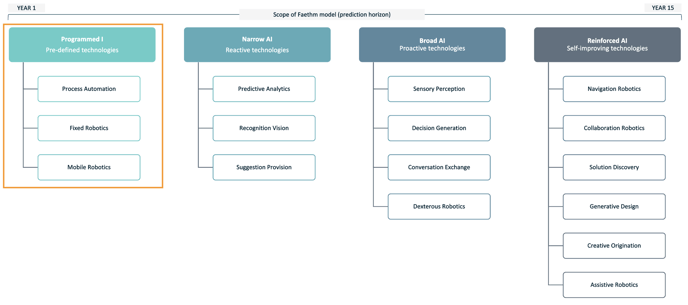Programmed I
Programmed Intelligence technologies are pre-programmed and are hence non-autonomous.

Programmed I depends entirely on human input. These technologies can perform highly structured and simple process tasks by employing rules-based logic, processes, instructions and simple robotics.
Process Automation
Code programmed to complete pre-defined, logical and rule-based processing tasks.
- Robotic Process Automation (RPA)
- Agile Process Automation (APA)
For example, EY assists clients with the implementation of numerous RPA technologies including those that support HR and payroll processes. The software acts as a virtual co-worker assisting with on-boarding, payroll actions and processing errors and data compliance issues.
Fixed Robotics
Fixed machines that robotically handle/ manipulate objects in a pre-defined way.
- Assembly robots
- Construction robots
- Home and service robots
For example, Boeing utilises numerous manufacturing robots to assist in building aircraft. They use a Fuselage Automated Upright Build system to assemble the front and rear section of each 777 fuselages, replacing what used to be a physically tiring and long manual job.
Mobile Robotics
Mobile machines programmed to move between points in a controlled environment.
- Mobile materials handling
- Basic point to point transport systems
- Autonomous inventory robots
For example, Amazon uses autonomous picking robots to deliver, pick and arrange products within its warehouses. The robots bring shelves of goods out of storage and carry them to employees, cutting out much of the hard-manual picking work and allowing Amazon to retrieve more items for more customers simultaneously.